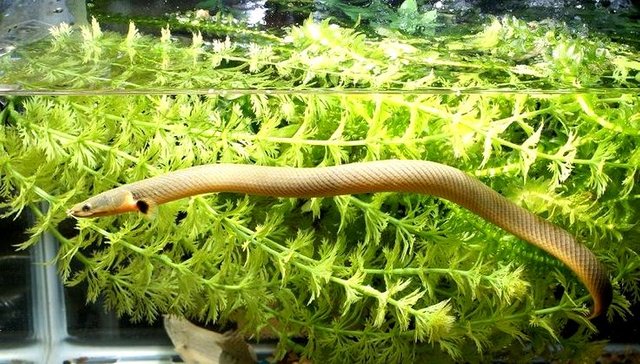My aquarium fish (Erpetoichthys calabaricus)
Description of Erpetoichthys calabaricus, Reed Fish:
The reef fish Erpetoichthys calabaricus is a species of freshwater monospecific of the genus, native to West Africa, in its central part from Nigeria to the North (mouth of the Ogun River), as far as Congo Brazzaville (river Chiloango) in the South and reed fish, formerly Calamichthys calabaricus, evolve in near-stagnant waters and always with low current.

Of elongated shape like an eel, the reed fish could also be named eel fish. This particular morphology is completed by 7 to 13 small notches on the dorsal fin that touches the caudal fin. Erpetoichthys calabaricus does not have a ventral fin and the pectoral fins are fan-shaped. The general body color is pale to yellow to orange gold. The back is dark olive green to brown.
Like all Polypteridae, reed fish periodically rise to the surface to breathe atmospheric air through a system connected to the bladder, the swim bladder. Able to breathe air, so it can tolerate quite low oxygen concentrations. Larvae have external gills and resemble salamander larvae. Its sight is very weak and its survival depends on the smell to identify food; if these foods are inert, they must be appetizing to smell. This species requires frequent partial water changes to thrive.
Maintenance and breeding sheet of Erpetoichthys calabaricus:
How to maintain, associate, feed, breed and breed Erpetoichthys calabaricus (Reed Fish)? Which settings to choose?
Water quality:
What are the best maintenance parameters? What type of water is preferred?
The maintenance of this reed fish Erpetoichthys calabaricus should rather be carried out in a specific aquarium hermetically covered with a substrate base composed in part of fine sand (Loire sand type) and a little peat. However, slightly acidic and soft water should always be clean! No nitrates, this fish does not tolerate well loaded waters.

Reed fish is a delicate fish in aquarium, quite difficult.
Cohabitation and behavior:
What behavior does the animal have? With which other animals is it compatible? Is he sociable?
In order to reproduce the original biotope of almost stagnant water with abundant vegetation between tree roots, an attempt will be made to recreate such an environment by entangling bog roots or, as its common name suggests, to reeds (like Juncus for example). If during the day, the activity of the reed fish is modest, it becomes very active at sunrise (lighting of the light) and just before the night, it can thus be qualified as a crepuscular fish.
Even if it is not advisable to put two reed fish together in an aquarium of less than 300 liters, it is still possible, in an aquarium of more than 500-600 liters to introduce a couple, to see a group of 6 specimens (which corresponds to their way of life in swamps); sexual dimorphism is easily expressed on adults (or fish over 20 cm) because the male has 12 to 14 rays in the dorsal fin when the female has only 9 rays. In addition, the anal fin of the male is very dark when the female shows a light ocher color.

This species can be combined with other medium-sized to large fish (no invertebrate!) And species that are not too aggressive. The small fish will be eaten! Thus, here are some suggestions to populate a large aquarium: Steatocranus, some tilapia, Hemichromis, Synodontis and if we change continent, we can perfectly add them scalars or discus for example.
Food and Food:
How to feed him? Which diet is best? At what frequency?
Rather carnivorous, he obviously consumes earthworms, tubifex, larvae of insects, small frogs (a dish of choice!), Minced meat; occasionally, well-acclimated fish will accept food in tablets but it is sometimes delicate.

Encyclopedic Information (Reed Fish):
What does E. calabaricus have in particular? Are there special uses?
Reed fish is the common name of Erpetoichthys calabaricus, a freshwater fish from West-Central Africa that swims mostly in swampy areas, with almost no water flow, on dense vegetation bottoms. . But if the legend wants this fish to reach more than 80 cm, this has never been officially confirmed. A size of about 40 cm for this serpentiform fish is already substantial in the aquarium.

This is amazing
thanks you :)